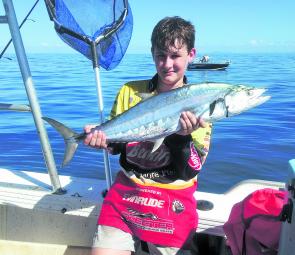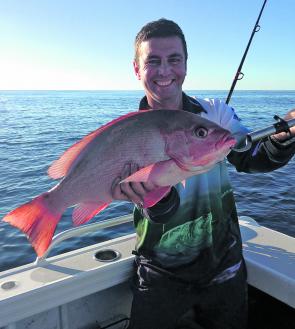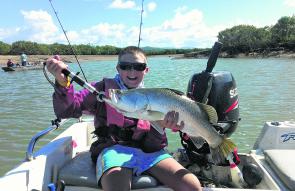There has been a fairly good show of snapper in the waters around the islands lately. Though we do get them in ones and twos when the water temp drops that little bit every winter, this year is different. Instead of the large fish, this time we are getting small to medium fish, or what I would call squire. The bonus is that they are in much better numbers than the normal big fish and they seem to be in a wider variety of spots. I would try any of the local grassy sweetlip haunts for a start, and any of the shallow water mackerel spots close to The Keppels.
A few years ago we had an unusual amount of very small squire at spots like Halftide Rocks and Pumpkin Passage. This could be the same population having grown a bit and staying in the local vicinity. We were catching them on the same plastics you would use for bream, and the same baits including cut prawns and yabbies.
School mackerel usually slow right down by July but, along with Spanish mackerel, they are having an extended run. We have been scoring a few large doggies (Queensland school mackerel) around the islands and have had to leave different spots because they were so thick you couldn’t get a bait down to reefies. The mackerel could be around for a while yet as long as the bait schools remain.
Floating out lightly weighted pillies while bottom bashing is the easiest way to get a mackerel, though spinning and jigging with chromies is by far the most entertaining. The pick of the spots are Wedge and Pelican out from Emu Park, or out from Yeppoon there is Barren, Findlays, Forty Acre and Conical. The bumper year should continue and if current indications are anything to go by, the spotty season in a month or two will be a cracker.
Spanish chasers haven’t been left out either, as the majority of reefy lumps along the contour lines are producing quality Spaniards. There are still a few fish around the regular mackerel spots from Liza Jane, Barren, Man and Wife, Outer, Conical, Flat, Perforated and Manifold. Big troll baits, lures, floating pillies and again my favourite jigging Flashas or Taipans.
Grunter haven’t really gone anywhere this year, as time after time when the conditions are right you can get them at any of the local spots. The offshore spots from The Pinnacles, The Barge, Cape Manifold, The Rama, Findlays and Cape Capricorn all had grunter over the moon. Grunter don’t always hang around the structure and lots of times they will be in the pressure wave in front of ridges or schooling under the current in the undulations caused by the current run. Prawns, squid and pillies have been the pick of the baits.
Four nights either side of the full moon is prime jew fishing time. Black jew, our local species, seem to fire as soon as the moon peeks over the horizon – although whenever the wind drops and the tide is rising in the evening, jew come to mind. Other times can be worth a go as well, especially the new moon.
If you are looking to land a black jew for the first time, the best places to try are Iron Pot, The Double Heads jew hole, Rita Mada, Mother McGregor, Corio Heads, The Barge, The Pinnacles, The Rama and Findlays. Jew are an extremely tough and dirty fighter on light gear, and will test you and you tackle thoroughly.
Despite theories from many people, jew will definitely take a fresh bait or decent sized live bait over anything else. One thing I can say for sure is that they also prefer ‘fish of the day’, meaning that anything schooling in that area during the day is going to be the best bait that night. Doggy mackerel and ribbonfish are two prime examples, with live or fresh squid up there in the mix. Pilchards do the trick as well, and should be a standard backup. Paternoster rigs or a running ball sinker over an 8/0 both work well.
King threadfin salmon have again led the way in The Fitzroy River. They are chewing throughout most of the river from the town reaches to The Narrows. Lures, prawns and pilchards have accounted for plenty of salmon in recent weeks. The jetties in town and the high mud banks heading downstream are favourite salmon spots. These fish have also been in serious form in Coorooman Creek, as some of the biggest kings caught around have been taken there in recent weeks. Just like the river, around eddies and the shallow mouths of prawn gutters are a fine starting point when you are looking for a king.
King threadfin come right into very shallow water chasing prawns, crabs, yabbies and other critters. Most salmon are caught just on dark or daylight as a rule, but tides are also an important factor when targeting threadfin.
Coorooman Creek has also been showing up some quality blue salmon, and one or two of the fish taken this week were 900mm+ blue salmon. The best baits have been prawns or yabbies, and blues will take shiny lures like Flashas using the jig-and-pause method. Plastics are another good option, with the more realistic types working well.
My fish diary keeps flashing bonito and ribbonfish this week. All the dry years in the past 20 years have had regular bait schools through the bay, and the best months for horseys and wolfies have traditionally been July and August.
There have been reports of a few schools of bonito moving into the area in recent days. Bonito will take any fast retrieved small chrome lure or hard body.
Ribbonfish have come in again after a pretty slow couple of years at quite a few of the closer doggie mackerel spots like Corio Heads, Rita Mada, Ironpot, Quartz Rock out from Keppel Sands, Cave and Wedge isles just off Emu Park. Ribbonfish are among the best baits of for Spanish mackerel, wahoo and many other pelagics when trolled whole. They are also exceptional as a slab bait for black jew or strip baits for reefies, and they make a great addition to a chopped up berley mix because of their oily flesh.
Ribbonfish will keep for a long time when they are treated properly after the catch. For best results, lay them flat and cover with ice. Once home I dry them and rig a few up on gang hooks before individually wrapping them in gladwrap and laying them in a single layer in the freezer. They come out in pristine condition which makes them irresistible to predators.
The many local squid spots are firing at the moment, with a fair few squid being caught in recent weeks. One method that seems to do the trick is to troll very slowly over the shallows around the islands with a couple of floating jigs hanging out the back. Soak your squid jigs in pilly juice or tuna oil to give that little bit of extra appeal. As the jigs pass over the colour changes (sand to reef) the squid will come out and nail the jigs. Once you have found where the squid are you can then anchor and cast the jigs over the spot.
Places to chase squid range from Rosslyn Bay Harbour at night, Outer, Pumpkin Passage, Man and Wife, The Keppels, or virtually anywhere you get contrasting bottom colours.
Whiting and dart have made their presence felt locally. The beaches and creeks north of the river, Keppel Sands, Kinka, Mulambin, The Causeway, Lammermoor, Ross Creek, Bangalee and Farnborough are great for whiting.
Dart will be in numbers from Three Rivers, Five Rocks, Nine Mile, Corio, Farnborough and Bangalee down to Yeppoon. Yabbies and beach worms are the better baits with peeled prawns as a reserve. The majority of fish caught are right in close at your feet, it is a waste of time and effort casting too far. Results improve on the run-in tide on the beaches. The creeks and sandbanks in Corio and Coorooman have more options, particularly around the yabby beds.
Flathead, bream, queenfish and trevally are also likely captures for anyone fishing the estuaries or the islands beaches in coming weeks. All the estuaries have at least something to offer most of us, and with the good fish reported in recent weeks why wouldn’t you get out there? Bream prefer structure-rich country like oyster banks, fallen trees and mangrove roots. You’ll find them everywhere from the deepest parts of the creeks right into quite shallow water as the tide moves in. Bream will eat nearly anything including yabbies, pillies, worms and flesh strips.
Reads: 3420
Deakin Smithwick landed some quality doggy mackerel on high speed jigs.

Aaron Lewis with a 69cm nannygai caught locally.

Brendan Reed with his first keeper barra caught at Coorooman Creek.




